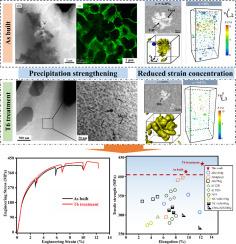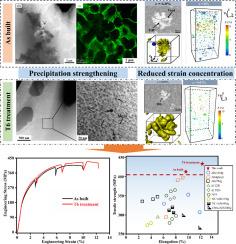Simultaneously enhancing strength and ductility of laser directed energy deposited TiB2/AlSi10Mg by inducing dispersed Mg2Si precipitation and reducing strain concentration
IF 12.8
1区 材料科学
Q1 ENGINEERING, MECHANICAL
引用次数: 0
Abstract
Laser directed energy deposition (L-DED) has been widely used in metal additive manufacturing due to its advantages in terms of large dimensions and high forming speed. However, the limited mechanical properties and ductility of components have hindered the broader application of this technology. In this research, we have achieved a simultaneous enhancement of yield strength and elongation in TiB2/AlSi10Mg composites after T6 heat treatment fabricated by blue l-DED technology. The T6 heat-treated TiB2/AlSi10Mg composites exhibit a yield strength, tensile strength, and elongation of approximately 289.4 MPa, 431.3 MPa, and 12.3 %, respectively, representing exceptionally high values. An in-situ imaging technique utilizing X-ray computed tomography (CT) is firstly implemented to explore the evolution of defects, TiB2 particles, and microcracks during the deformation process. In the process of plastic deformation, new voids nucleate at the interface between the Al matrix and TiB2 particles with a large size (>25 μm), leading to damage accumulation. Furthermore, based on the modified Gurson-Tvergaard model, a new critical strain value of TiB2 particles (∼8 %) for void nucleation is proposed. After T6 heat treatment, no significant grain coarsening occurs due to the “pinning” effect of TiB2 particles on the grain boundaries. Lots of fine dispersed Mg2Si phases (quantity density about 3.1 × 1015 m-2) show more obvious precipitation strengthening. This research provides valuable insights to further promote the development of high-performance aluminum matrix composites by the l-DED process.


激光定向能沉积TiB2/AlSi10Mg的同时,通过诱导Mg2Si的分散析出和降低应变浓度来提高TiB2/AlSi10Mg的强度和延展性
激光定向能沉积(L-DED)由于具有尺寸大、成形速度快等优点,在金属增材制造中得到了广泛的应用。然而,部件有限的力学性能和延展性阻碍了该技术的广泛应用。在这项研究中,我们实现了TiB2/AlSi10Mg复合材料经过T6热处理后屈服强度和伸长率的同时提高。经T6热处理的TiB2/AlSi10Mg复合材料的屈服强度、抗拉强度和伸长率分别达到289.4 MPa、431.3 MPa和12.3%,达到了极高的水平。首先利用x射线计算机断层扫描(CT)的原位成像技术来探索变形过程中缺陷、TiB2颗粒和微裂纹的演变。在塑性变形过程中,在Al基体与TiB2颗粒的界面处形成了大尺寸(>25 μm)的新空洞,导致损伤积累。此外,基于修正的Gurson-Tvergaard模型,提出了一个新的TiB2粒子空穴成核临界应变值(~ 8%)。经过T6热处理后,由于TiB2颗粒在晶界上的“钉住”作用,晶粒未发生明显的粗化。大量细小分散Mg2Si相(数量密度约为3.1 × 1015 m-2)表现出更明显的析出强化。本研究为进一步推动L-DED工艺发展高性能铝基复合材料提供了有价值的见解。
本文章由计算机程序翻译,如有差异,请以英文原文为准。
求助全文
约1分钟内获得全文
求助全文
来源期刊

International Journal of Plasticity
工程技术-材料科学:综合
CiteScore
15.30
自引率
26.50%
发文量
256
审稿时长
46 days
期刊介绍:
International Journal of Plasticity aims to present original research encompassing all facets of plastic deformation, damage, and fracture behavior in both isotropic and anisotropic solids. This includes exploring the thermodynamics of plasticity and fracture, continuum theory, and macroscopic as well as microscopic phenomena.
Topics of interest span the plastic behavior of single crystals and polycrystalline metals, ceramics, rocks, soils, composites, nanocrystalline and microelectronics materials, shape memory alloys, ferroelectric ceramics, thin films, and polymers. Additionally, the journal covers plasticity aspects of failure and fracture mechanics. Contributions involving significant experimental, numerical, or theoretical advancements that enhance the understanding of the plastic behavior of solids are particularly valued. Papers addressing the modeling of finite nonlinear elastic deformation, bearing similarities to the modeling of plastic deformation, are also welcomed.
 求助内容:
求助内容: 应助结果提醒方式:
应助结果提醒方式:


